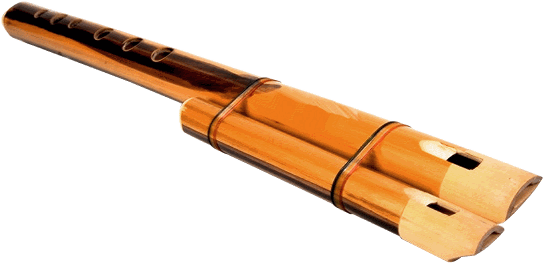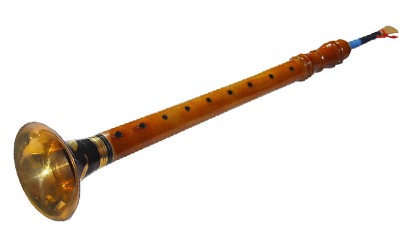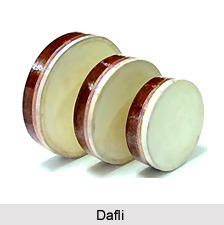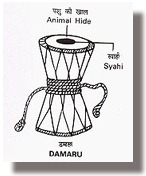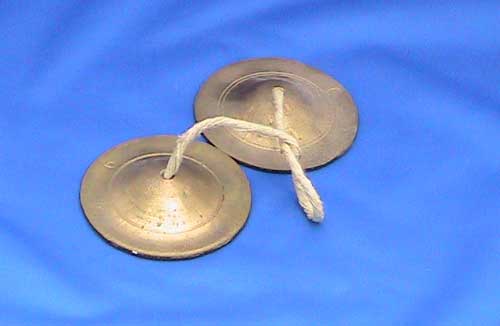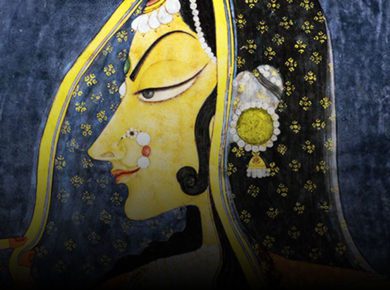Musical Instruments in India
Natya Shastra, compiled by Bharat Muni, divides musical instruments into four main categories on the basis of how sound is produced.
| Tata Vadya | Chordophones | Stringed instruments |
| Sushira Vadya | Aerophones | Wind instruments |
| Avanaddha Vadya | Membranophones | Percussion instruments |
| Ghana Vadya | Idiophones | Solid instruments |
Tata Vadya (Stringed Instruments)
- Sound is produced by the vibration of a string or chord.
- Vibrations are caused by plucking or by bowing on the string
- Degree to which string is tightened, determines pitch of the note & also, to some extent, the duration of the sound
- Increase or decrease in the length of the vibrator wire is responsible for the changes in pitches of notes-swaras.
- Harps [arr] Oldest evidence in the shape of the hunter’s bow.
- Veena was the generic term for stringed instruments’ referred to in texts
- Another class is of the dulcimer type, where a number of strings are stretched on a box of wood [arr] Santoor
- Bowed instruments – the upright (Sarangi) and the inverted (Violin)

[clear]
|
Different parts of a stringed instrument |
|
| Resonator (Toomba) | Either made of wood or from a specially grown gourd |
| Tabli | Wooden over this Toomba |
| Danda | Resonator attached to the fingerboard, at the top end of which are Khoontis, for tuning the instrument |
| Bridge | A bridge made of ivory or bone on the Tabli |
| Tarab | Main strings passing over the bridge – When these strings vibrate, they add resonance to the sound |
Sushira Vadya (Wind Instruments)
- Sound is produced by blowing air into an hollow column
- Pitch of the note is determined by controlling the air passage
- Melody is played by using the fingers to open and close the in the instrument
- Indus civilizations excavations [arr] bird whistles of clay, wind and percussion instruments inscribed on seals
- Wind instruments are roughly divided into two categories on the basis of how sound is produced viz.
Flutes
- The simplest of these instruments, generally made of bamboo or wood
- Mostly played by musicians of the tribal and rural areas
- Resembles beak flutes which have a narrow aperture at one end.
Reed
- Have one or two reeds inserted in the hollow beak or tube of the instrument – which vibrate when air is blown into them
- Reeds are bound together with a gap between them before inserting into the body of the instrument.
- The body of the tube is conical in shape; narrow at the blowing end and opening out gradually, with a metallic bell at the farther end to enhance the volume of the sound
- A set of spare reeds, an ivory or silver needle for adjusting and cleaning the reeds are also hung from the mouth piece of the instrument.
- Examples [arr] Shehnai & Nadaswaram
Avanaddha Vadya (Percussion Instruments)
- Sound is produced by striking the animal skin which has been stretched across an earthen or metal pot or a wooden barrel or frame
- The earliest references to such instruments have been found in the Vedas where there is mention of Bhumi Dundhubhi
- Bhumi Dundhubhi was a hollow pit dug in the ground and covered with the hide of a buffalo or ox which was stretched across the pit
- The tail of the animal was used for striking the animal hide and thus sound was produced
- Examples [arr] Oordhwaka, Tabla, Ankya, Alingya & Damaru
Oordhwaka
- Oordhwaka drums are placed vertically before the musician and sound is produced by striking them with sticks or the fingers.
- Prominent among these are the Tabla pair and Chenda
Tabla
- Tabla pair is a set of two vertical Oordhwaka drums
- Right side is called the Tabla and the left, the Bayan or Dagga
- Tabla pair is used as accompaniment to vocal and instrumental Hindustani music and with many dance forms of northern India
- Prominent musicians [arr] Ustad Alla Rakha Khan and his son Zakir Hussain, Shafat Ahmed and Samata Prasad
Tabla
|
Bayan
|
Ankya
- Ankya drums are held horizontally before the musician and usually both sides are covered with animal hide
- Sound is produced by striking both sides with sticks or fingers
- Prominent examples include Mridangam, Pakhawaj & Khol
- Seals which have been excavated of the Indus Civilization show figures of men playing the horizontal drums hung from the neck
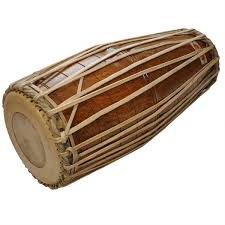
Alingya
- Drums having the animal skin fixed to a wooden round frame
- Held close to the body with one hand while the other hand is used for playing on the instrument
- Notable example [arr] Duff, Dufli
Damaru
- Ranges from the small Huddaka of Himachal Pradesh to the larger instrument known as Timila of the southern region
- Huddaka is struck with the hands while Timila is hung from the shoulders and played with sticks and fingers.
- Also known as the hourglass variety of drums as their shape resembles an hourglass
Ghana Vadya (Solid Instruments)
- Earliest instruments invented by man
- Once constructed, this variety of instrument do not need special tuning prior to playing
- Principally rhythmic in function and are best suited as accompaniment to folk and tribal music and dance
- Notable examples [arr] Jhanj, Ghatam
Jhanj Player, Konarak, Orissa
- Sun temple (Konarak, Orissa) [arr] large sculpture of a lady playing the Jhanj
- Jhanj is also known as manjira or cymbals
Ghatam, Carnatic music
- An earthenware pot [arr] the artist uses the fingers, thumbs, palms, and heels of the hands to strike its outer surface
- An airy low-pitch bass sound, called Gumki, is created by hitting the mouth of the pot with an open hand
- Artist sometimes presses the mouth of the pot against their bare belly, which deepens the tone of the bass stroke (Gumki)
- Different tones can be produced by hitting different areas of the pot with different parts of the hands
- The Ghatam usually accompanies a mridangam
